Recognized Friends and Adversaries
by Sachi Sri Kantha, May 9, 2022
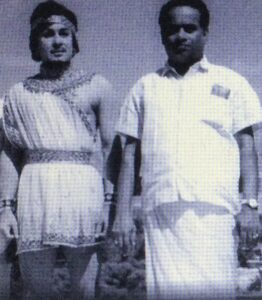
MGR in costume for ‘Adimai Penn’ (1969) movie with M. Peethambaram
Fellow MGR biographer R. Kannan’s comments, on Part 65, received on April 1st, expanded a little on the conflict that Communists (CPI) had with DMK, in early 1970s. For the uninitiated, Karunanidhi is referred by his honorary sobriquet among DMK sympathizers: ‘Kalaignar’ (i.e., artist).
“Enjoyed reading Part 65 of MGR. I see the scan of the various sources and the commendable effort at tying them together towards a cogent narrative. A few comments are in order:
The differences between the Left and the DMK began when under Kalaignar’s leadership the party began to expand its footprint into the trade union arena breaking the coyish attitude under Anna. The DMK was accused of union-busting and thuggery. Simpsons, as Kalaignar records was emblematic of the tension between the erstwhile allies. Kalaignar alleged that Kalyanasundaram wished to ‘control’ the DMK ministry and had advised an all-party steering committee to guide the government. Of course, he had rejected the suggestion. This, according to Kalaignar, pitted the CPI against him.
[Thus] Kalyanasundaram and Baladhandayutham became MGR’s advisors that EVR[amasamy Naiker – aka Periyar] said ‘this mischief is caused by two sat-sudras‘. Nanjil Manoharan, an experienced man at Delhi, came aboard on 15 November 1972 only a month after the founding of the ADMK. However, the two communist leaders brought a fresh perspective to MGR’s crusade and importantly gave him the much needed validation from the Left. The CPI(M) was unsure of MGR and had asked that he spell out his policies. It was in Dindigul that the CPI(M) came on board.
On the 15 Feb, 1973 Marina speech Indira Gandhi said that while Anna understood the nuances of Indo-Lanka relations post Anna the DMK leaders were making unrealistic demands queering the pitch for Indo-Lanka friendship.
Wikileaks of that period shows that some 7000-8000 people were taken into custody soon after the dismissal of the ministry on 31 Jan 1976 but they were released by the end of Feb or March. Here is the excerpt from the Shah Commission on the MISA numbers et al.,
The Shah Commission noted that 1,027 were arrested under MISA of which DMK men numbered 419 followed by CPI-ML with 72 and RSS 47 and DK (35). Shah observed that except for an AIADMK man arrested under MISA during the DMK administration there were no detentions of persons from political parties. Shah reported:
DMK, had to bear the brunt of MISA onslaught followed by Dravida Kazhagam. Majority of DMK and DK men were accused of having rowdy elements under their command, likely to indulge in prejudicial acts and critical of the Emergency and president’s rule. Grounds of detention also mentioned anti-government or secessionist speeches but no place, date or time of the speech given. Interference in the district administration and amassing wealth by corrupt practices were other grounds.
Shah said despite the absence of specific instructions from the government the ‘District authorities went about using MISA extensively against the members of DMK …simply by furnishing vague and general grounds in a stereotyped manner.’[i] The DMK claimed a figure of 500 DMK men under MISA and another 25,000 DMK cadres arrested during the Emergency attributing Chittibabu’s and Sathur Balakrishnan’s deaths to the confinement.[ii] During this period the party sent a stipend of 200 rupees to 124 families and 100 rupees to twenty-three families and incurred an expenditure of 188,000 rupees.[iii]
[i] Shah Commission Final Report, ed. Era. Sezhian, cols. 19.288 to 19.299.
[ii] Kalaignar Kadithangal, vol. 11, pp. 3.
[iii] Kalaignar Kadithangal, vol. 10, pp. 107.”
I completely agree with all the comments and additions provided by Kannan. I’m inconvenienced by the non-availability of the three citations of Kannan, in Japan.
Recognized Friends
MGR reached 60 on January 17, 1977. Prior to the political events in the first half of 1977 when he was elected as the Chief Minister of Tamil Nadu, permit me to backtrack 5-7 years earlier (circa 1970-72); MGR serialized his autobiography in the Ananda Vikatan weekly, between the ages 53 to 55. It began to be serialized from April 1970, and came to an abrupt ending in October 1972, when he was thrown out from DMK. In the 134 installments, MGR had dictated numerous friendly and unfriendly interactions he had among his circle of Tamil drama-cinema personalities. One caveat.
The source I refer for this chapter is the 2014 published version by the Kannadasan pathippagam, run by Gandhi Kannadasan (one of Kannadasan’s sons). Except for a few installments which I collected half a century ago and cited earlier in this series (before I came into contact with R. Kannan in 2013), I couldn’t check all the chapters of the originally serialized version in the Ananda Vikatan. As there was a court case on the ownership of copyrights between MGR’s adopted son J. Surendiran and another party, from reading other sources, I have reasons to suspect that some described details by MGR in the originally serialized version had been omitted/deleted in the 2014 published version of the autobiography.
Though in his adult life, he would have met, got acquainted and interacted with literally hundreds or thousands of individuals of both sexes in India alone, those whom MGR recognized or qualified as friends/dear brothers [‘Nanbar’ or ‘anpu sahotharar’ to use his specific terms in Tamil] and provided snippets in his autobiography, amount to only fifteen. These are,
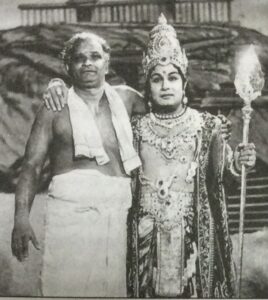
Chinnappa Thevar (lt) and MGR (rt) in the role of Lord Murugan, for ‘Thani Piravi’ (1966) movie
music director S.M. Subbiah Naidu (1914-1979)
villain actor M.N. Nambiar (1919-2008)
stage and cine actor K.R. Ramasamy (1914-1971)
cine producer Sandow M.M.A. Chinnappa Thevar (1915-1978)
stage and cine actor Sivaji Ganesan (1928-2001)
actor and lyricist N.M. Muthukoothan
movie editor/director A. Kasilingam
stage and cine actor S.V. Sahasranamam (1913-1988)
stage and cine actor D.V. Narayanasamy
writer/movie director P. Neelakantan (1916-1992)
‘duck duck’ Rangan
Sama Naidu (Samannan)
villain actor N.S. Natarajan (aka Putur Nadarajan, ? – 1990)
make-up artist M. Peethambaram (1922-2011)
DMK leader P.U. Shanmugam (1924-2007)
About the gratitude he had for his makeup man Peethambaram’s family, MGR had written: “,Mr. Peethambaram is the son of a mother, with whom my mother had very intimate link. My father’s death occurred when I was two and a half, at the house of the grandmother of Peethambaram. Later, when my mother met Peethambaram after 20 years, she cried passionately in a manner, that she had reminisced the events that had just happened.,,,
I should be so grateful to the deeds done by Peethambaram’s parents. Is it adequate, if I simply mention this in writing now? Peethambaram who was born in that family helps me even now. When I think about it, that he helps me to receive laurels in my career, my mental burden increases. I’m the one who should show gratitude to him. But, he is the one who continues to help me. I carry this anguish that I haven’t done anything for him.”
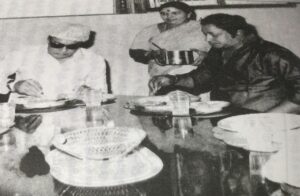
MGR and Sivaji Ganesan. Between them is Ganesan’s wife Kamala
In the 6th chapter, with a sub-heading ‘Trust and Friends’, MGR provides three names mentioned above. This particular chapter relates to his impressions on the production experience of his 1961 hit movie, ‘Thirudathe’ [Do not Steal]. MGR had stated,
“Though the experiences related to the production of ‘Thirudathe’ movie gave me testing times and sorrow for my mind, the truth is it did provide a lift to my artistic career, and the trust others could have on me (why, even for me).
Many friends were responsible for this particular change on my activities. I will be defaulting in my conscience, if I ignore the collaboration of Mrs. Sarojadevi, who accepted the views of the director and me.
Akin to this, I cannot forget the cooperation of other artistes – Mr. M.N. Nambiar, director Mr. P. Neelakantan, Mr. K.A. Thangavelu, actress Mrs. M.N. Rajam, G. Sakuntala, poet Pattukottai Kalyanasundaram, music director Mr. S.M. Subbiah Naidu. How I got acquainted with these folks and how this acquaintance blossomed to flower, I’ll be writing in full details later. First, I provide my thoughts on the music director of this ‘Thirudathe’ movie, ‘sibling’ Mr. S.M. Subbiah Nadu…”
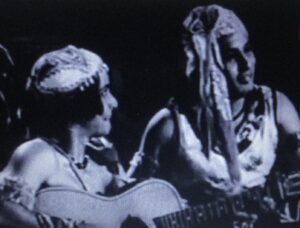
M.N. Nambiar (lt) and MGR (rt) – screen grab from ‘Rajakumari’ (1947) movie
However, after 134 chapters, MGR could describe in full, only his relationship with M.N. Nambiar and director Neelakantan, apart from that of Subbiah Naidu. As the series came to an end abruptly, nothing further was mentioned about other artistes (Sarojadevi, Rajam and G. Shakuntala, as well as Pattukottai Kalyanasundaram) he had listed in chapter 6.
It’s rather unfortunate that MGR had not elaborated, in his autobiography, about the relationship and conflicts he had with his illustrious pal and rival, Sivaji Ganesan. Exception being a joint effort by both of them in 1957, to criticize the Kumudam weekly for creating an ‘artificial rivalry’ between their fans by engaging in a competition to boost the sales of the weekly.
Also, in chapter 98, MGR mentions that when he visited Kuzhalmannam village in Palakkadu district, Kerala to look at his second bride, arranged by his mother with a specific condition, ‘Do not reject adamantly’, he went with his friends. But, do not identify specifically, with whom he went.
Noted Adversaries
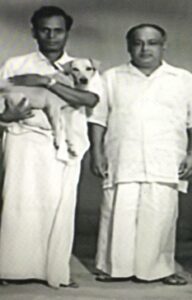
M.A. Ganapathy Bhat (rt) – screen grab from Bhommai (1964) movie
Whom did MGR consider as his adversaries? In his autobiography chapters, four can be identified. These were,
A childhood actor, Balakrishnan, at the Madurai Original Boy’s Company.
lawyer and journalist-politician S.P. Adithan (1905-1981)
stage and cine actor M.R. Radha (1907-1979)
make-up man and cine actor M.A. Ganapathy Bhat (1915?-1972)
This listing was, as of 1972. Then, after 1972, MGR considered DMK leader M. Karunanidhi (1924-2018) and Sri Lankan president J.R. Jayewardene (1906-1996) as his two foremost political adversaries. In this chapter, lets focus on the first four listed above.
Press baron S.P. Adithan
What happened to MGR’s childhood adversary Balakrishnan at the Madurai Original Boy’s Company (during ~1925-1935), is lost to history. S.P. Adithan carved a name for himself in Tamil Nadu as a print media baron, by publishing Thanthi (Telegram or The Wire) since 1942, which catered for the prurient interests on cinema and crime of the semi-literate Tamil masses, who could read Tamil alphabets. Adithan’s career in journalism has been analyzed by Francis Cody in 2009. He was accommodated by Anna during his 1967 successful campaign in the Legislative Assembly elections. Only in the previous year 1966, MGR had released a movie ‘Chandrothayam’ (Rising Moon) to satirize Adithan-brand journalism, with M.R. Radha (MGR’s other adversary) playing the villainy role with the name Duriothanan, the arch villain in the Mahabharatha epic. [see, Part 34 of this series https://sangam.org/mgr-remembered-part-34/] However, after Adithan made his exit from DMK with V.R. Nedunchezhian, K. Rajaram and S. Madhavan in April 1977, MGR accommodated Adithan, simply to politically marginalize Karunanidhi.
Karunanidhi recorded the duplicity of Adithan as follows:
“…Only three days April 12, 13, 14. Someone had twisted the mind of Navalar [aka, Nedunchezhian]. He had announced that he will leave the party on 15th, and establish a new one. I could only smile, that the one who had supported and induced this decision was Adithan. After the death of Anna, while those like me were of opinion that Navalar should become the chief minister, Navalar was very firm that Adithan should not be given a Cabinet post. Subsequently, with the exception of one or two, all the legislative members of the party insisted that I should become the chief minister, and I became one, it was MGR who was against accommodating Adithan in the Cabinet. But, without accepting his viewpoint, I accommodated Adithan in the Cabinet.
I have never resisted praising Adithan’s contribution to the Tamil press, as an uncrowned king; in establishing Dinathanthi as the main river, and guide post to Dinakaran, Malai Murasu as excellent tributaries as well as his passion to Tamil sentiments. But, when I heard, this Adithan did leave DMK with Navalar and helped him to establish his new party, cannot I laugh at his deeds? Was it a pleasant thought? No, no – it was only the hurt sentiments.
Adithan had press power as well as money power. He thought that both of these are adequate to begin a new party and demolish the boundaries of [our] party. Very soon, he learnt that how his decisions were in error. He also learnt about Navalar – the individual. The new party of theirs didn’t last long. They named it ‘People’s DMK’. They thought that those who had received financial help from them would stand by them. But, none of our party’s devotees were not willing to bargain DMK’s principles to Adithan’s assistance.”
M.R. Radha
MGR’s troubled relationship with M.R. Radha, first as his mentor [part 33 https://sangam.org/mgr-remembered-part-33/] and then as his assailant in 1967 [parts 34 to 40], had been presented in earlier chapters. Even after his release from the prison in 1971, that Radha continued to tweak MGR’s nerves was recorded rebutted by the latter defiantly in December 1971. Excerpts:
“Recently few friends brought to my attention an article published in the Dinamani Kathir journal. It was said that M.R. Radha annan had written it. I was flabbergasted to note that it carried some false items about me. To write something which did not occur and put into my mouth an answer which was not delivered. Those who know correctly the issues concerned – how can they remain without laughing at these silliness. I cannot even grasp why this elder has to write a lie?
‘Even if others drink [alcohol], he wouldn’t drink. Now, some come and tell me that even he’s drinking [alcohol]. But, I’ll not believe.’
[According to him] I didn’t drink earlier. Now, someone had told him that Ramachandran is drinking. Then, he writes negating this, ‘I will not believe.’ Poor soul.
One who attempted to kill me, and legally got this was proved, and he received a prison sentence and served that. To this person, those good friends had gone to complain about me. Don’t we recognize these folks?…”
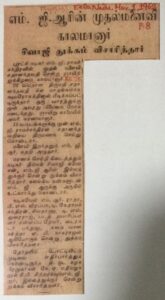
MGR’s wife Sadananthavathi’s death, Feb. 25, 1962
It should also be noted that Radha had a cordial relationship with MGR, prior to 1967, as evinced by a news report in EelaNadu newspaper of March 1, 1962, I had gathered (presented nearby), relating to the death of MGR’s second wife Sadananthavathi. Radha was one of the earliest visitors who had visited MGR’s house to offer his condolence. I provide a translation of this news report, for the interesting details (but with few errors), it provide about MGR’s wife and the personalities who had visited to offer condolence.
“Revolutionary actor M.G. Ramachandran’s first wife Sadananthavathi died last Sunday. 36 year old Sadananthavathi was suffering from tuberculosis for the past few months. Her condition worsened a week ago. She died on Sunday morning.
M.G. Ramachandran married Sadananthavathi 15 years ago. Following the death of his wife, MGR screamed and cried. After hearing the death news, Nadigar Thilakam Sivaji Ganesan visited MGR’s house to offer condolence. With teary eyes, he was seated next to MGR.
Nadigavel M.R. Radha, P.S. Veerappa, T.K. Ramchandran, Sivathanu, T.S. Durairaj, film producer Chinnappa Thevar, director Panthulu, script writer A.P. Nagarajan also visited to offer condolence.
Among the DMK figures, those who contested the elections and awaiting the results such as K.A. Mathiazhagan and C.P. Chittarasu also visited MGR’s house to pay condolence.”
Factual errors in this report include the following: (1) Sadananthavathi was MGR’s second wife. (2) MGR had married Sadananthavathi 15 years ago (either 1946 or 1947).
MGR had written in his autobiography that though Sadananthavathi was predicted only ‘three months’ to survive by the physicians who had treated her for tuberculosis, miraculously due to the risky treatment given by Dr.B.R. Subramaniam, she survived for 18 years. This indicates that MGR had married Sadananthavathi around 1944. According to biographer Kannan, the marriage of MGR and Sadananthavathi probably occurred in the same year that his first wife Bhargavi (Thangamani) died in 1942. An alternate view could be that, due to war time restrictions and displacement, MGR-Sadananthavathi marriage might have been legally registered after 1945, though conventional wedding could have taken place earlier. Unfortunately, MGR do not provide any specific dates about his first two marriages (arranged by his mother), and the ages of his wives, when he married them. At what age, MGR’s first wife died is lost to history. At least, the EelaNadu report indicates that Sadananthavathi died at the age of 36. It also indicates that M.R. Radha was one of the earliest to visit MGR’s house to offer condolence on the death of Sadananthavathi.
Apart from M.R. Radha, there was another individual in the cine field, whom MGR crossed swords, in 1950 and subsequent years. This was M.A. Ganapathy Bhat, a Kannada actor, who was the first husband of V.N. Janaki; she legally became MGR’s third wife in 1962, following the death of Sadananthavathi.
M.A. Ganapathy Bhat
In the first half of 1960s, M.R.Radha had acted with MGR in 20 movies. Between 1961 and 1966, Radha was a constant presence in MGR’s formulaic social movies. But, to my knowledge, Ganapathy Bhat never acted with MGR in a single movie. Nevertheless, since 1950, he was a familiar face with a rotund frame in quite a number of movies starring either Sivaji Ganesan or Gemini Ganesan in 1950s and 1960s. According to available details, Ganapathy Bhat had married Janaki in 1939, when the latter was around 15 or 16, and had given birth to a son Surendran (~either in 1939 or 1940). By, late 1940s, this relationship was floundering when MGR and Janaki paired together in the Mohini (1948) movie. [see, part 16 https://sangam.org/mgr-remembered-part-16/]
Following this, according to MGR, there prevailed ‘bad blood’ between him and Ganapathy Bhat for few years, for the rights to hold/retain the hands of Janaki. To his credit, MGR had described this struggle without any inhibition in many chapters of his autobiography. But, not even once, MGR mentions the name of Janaki’s first husband. He simply addresses him as either ‘person like a guardian’ or ‘the one who was a guardian to Janaki then’ [‘guardianai ponra oruvar’, ‘Janakiku appothu guardian-aha irunthavar’ were MGR’s choice phrases to Ganapathy Bhat]. MGR also indicates that Ganapathy Bhat (1) was a constant smoker, (2) owned a 10 year contract for Janaki for acting in specifically chosen movies, and ridiculed him as ‘Your family is big, you’re your sickly wife, mother, brother’s family; she has her brother, son and me. You current earnings now are only half of what she receives. You have yet to become a first rate hero. To protect your family and hers, she has to earn. Then only, you can live comfortably than now. But, I would allow her earnings to be spent on her family, but I’ll not allow her to earn to be spent on others…’ (3) demanded that he had to approve Janaki’s call-sheets for the movie ‘Marutha Naatu Ilavarasi’ (1950), then being made, (4) had accused and spread rumors that MGR was keen in enjoying the current and future earnings of Janaki. (5) had threatened Janaki that MGR would be physically assaulted, legs broken and killed in a simulated Jeep accident. Eventually, with the assistance and guidance of giants of the movie industry, director K. Subrahmanyam and his wife S.D. Subbulakshmi and Gemini studio boss S.S. Vasan, Janaki’s future was decided in favor of young MGR, following a legal verdict in this messy divorce suit.
As much as I had searched in the net, I couldn’t find much information on Ganapathy Bhat’s career, except a 12 min Youtube commentary in Kannada language by Hariharapura Manjunath [https://www.youtube.com/watch?v=Mpmo5fsoBy8]. Being illiterate in Kannada language, I could barely follow the details about his career – that he was born in 1915 and entered the movie world in 1939. He began his career as a make-up man at Pragathi Pictures and elevated himself as a comedian in the mold of Charlie Chaplin. He was also fluent in many Indian languages. Among the 12 minutes, one minute segment [5:37-6:35] provides details about his wife V.N. Janaki, who later married MGR. I doubt that Ganapathi Bhat’s angle on his conflict with MGR was presented in this commentary. I stand to be corrected here.
The conflict MGR had with Ganapathy Bhat related to his relationship with Janaki in 1950, has been viewed cynically by MGR’s critics, especially M.S.S. Pandian (1957-2014). To quote,
“…MGR’s ‘personal’ life was quite contradictory to the monogamous familial norms which he time and again preached on the screen. In fact, his real life would, within the cultural codes of Tamil society, meet all the requirements of a notorious home-breaker. First of all, he married thrice and was living with his third wife, V.N. Janaki, while his second wife was still alive. Secondly, he married his third wife while her earlier husband was still alive.”
To be fair by MGR, Pandian had twisted many facts (which he would know) to impress his warped viewpoint that MGR was a ‘notorious home-breaker’. Pandian should have read MGR’s autobiography, because he had cited it in his text. First, Pandian had ignored the chapters MGR had written about his conflict with Ganapathy Bhat related to divorce of Janaki. Secondly, it’s true that MGR married three times. But, not mentioned is the fact that he was a widower in 1942. He married his second wife Sadananthavathi, only after the death of his first wife Bhargavi. Thirdly, also ignored was the fact about Janaki’s preference to live with MGR and leave Ganapathy Bhat. This had been validated by the court case, described in detail by MGR. Fourthly, Ganapathy Bhat’s demands and ‘black mailing’ on Janaki’s derived income from her career as an actress, that Gemini boss S.S. Vasan considered as inappropriate demands of financial fraud.
This sort of fact-twisting by Pandian had been noted by many reviewers of Pandian’s work. For example, V. Jayanth, while reviewing the book for the Hindu newspaper in 1992, stated, “…Unfortunately, it [i.e., Pandian’s study] appears to be a biased picture, because he is trying to fit into his own trap, the events and policies of MGR the actor and politician.”
Cited Sources
Anon. Makeup man for MGR, NTR died. Times of India, Feb, 22, 2011. https://timesofindia.indiatimes.com/city/chennai/makeup-man-for-mgr-ntr-dead/articleshow/7542886.cms
Cody F. Daily wires and Daily blossoms: cultivating regimes of circulation in Tamil India’s newspaper revolution. Journal of Linguistic Anthropology, Dec 2009; 19(2): 286-309.
Jayanth V. The MGR phenomenon. Review of M.S.S.Pandian’s book ‘The Image Trap – M.G.Ramachandran in Film and Politics’. The Hindu international edition, 1992.
Kannan: MGR – A Life, Penguin Books, Gurgaon, Haryana, 2017, pp. 141, 179, 228.
Karunanidhi: Nenjukku Neethi, vol. 3, Thirumagal Nilayam, Chennai, 1997, pp. 100-101.
MGR: Naan Yean Piranthen, Part 1 and Part 2, Kannadhasan Pathippagam, Chennai 2014, pp. 912-914, 1049-1051, 1267-1344 (in Tamil).
Pandian, M.S.S. The Image Trap – M.G. Ramachandran in Film and Politics, SAGE Publications, New Delhi, 1992, p. 119.
- Shivaprasadh. Man who had the magic touch (on M. Peethambaram). The Hindu, Mar 3, 2011.
*****
Great article about friends/enemies of MGR from his own perspective, it is unfortunate that MGR stopped his series without detailing Sarojadevi, Rajam and G. Shakuntala, as well as Pattukottai Kalyanasundaram.
It was very interesting to read about Ganapathy Bhatt, the totally unknown person to many.